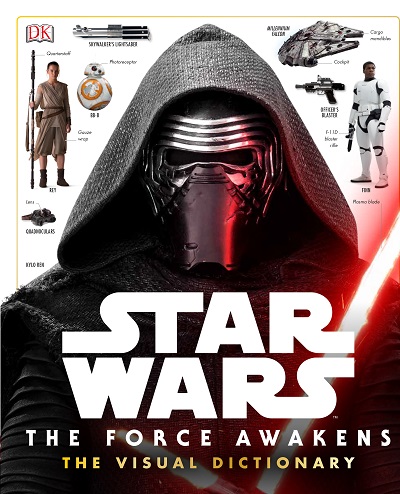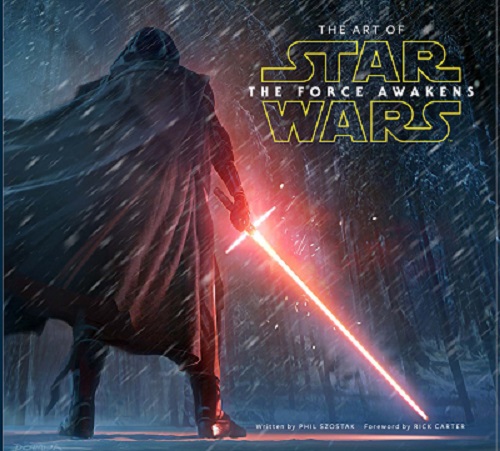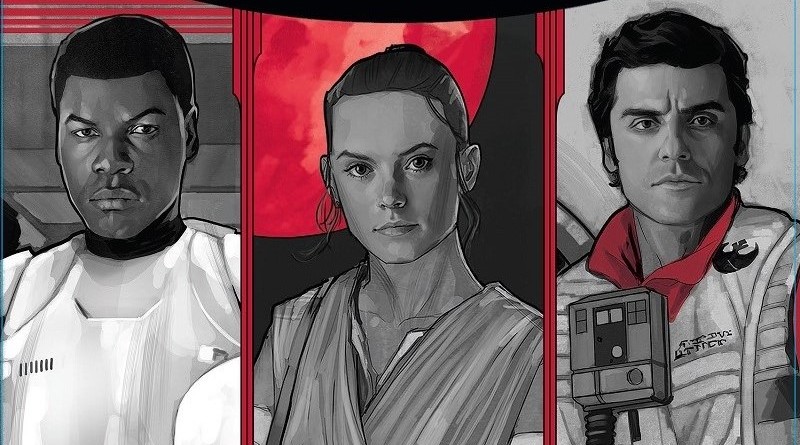Publishing Expands on The Force Awakens
 Note: This post references spoilers for The Force Awakens.
Note: This post references spoilers for The Force Awakens.
In preparation for Episode VII, Lucasfilm unveiled the Journey to The Force Awakens publishing program, which included a range of books for readers of all ages. World-building, backstory, and storytelling clues about the film emerged in the Shattered Empire comic from Marvel, the Del Rey novel Aftermath, and the YA masterpiece Lost Stars and a trio of middle-grade books from Disney-Lucasfilm Press. The Journey to The Force Awakens sparked considerable discussion and speculation, but it deliberately served as fairly oblique lead up to the movie rather than elaborating upon and broadening fans’ understanding of the core story revealed within the film itself.
Now that The Force Awakens has released, the publishing program has expanded to directly enhance the movie experience. Some of the biggest moments in the movie – the revelation of Kylo Ren’s parentage, Han Solo’s death – go unmentioned, likely to prevent spoilers from inadvertently leaking through books in progress. Likewise, some of the biggest questions raised by the movie – the identity of Rey’s family and how she ended up on Jakku, the origin of Supreme Leader Snoke – remain unanswered, presumably so they can be addressed in subsequent movies. Nevertheless, the newly released books provided a considerable amount of information, context, and detail to supplement the necessarily limited exposition in the two-hour movie. Our review of The Force Awakens novelization by Alan Dean Foster will come later; here are some of our recommendations and highlights from the complementary materials.
The Force Awakens Visual Dictionary, by Pablo Hidalgo
Fans familiar with previous versions of DK Publishing’s Visual Dictionaries, which cover both the Original Trilogy and Prequel Trilogy films, will find The Force Awakens edition fits the same mold and delivers a comparable amount of additional information expanding on the movie. Hidalgo’s sense of humor also peeks through in some of the captions, callouts, and sidebars for sharp-eyed fans.
 Most helpful, probably, is the clarification of the political status of the galaxy thirty years after the Battle of Endor, including the relationship between the New Republic and the Resistance and the scale of the First Order and the nature of the threat it poses. Throughout its pages, the book emphasizes the lack of resources available to both the Resistance and the First Order compared to their prior iterations as the Rebellion and the Empire, and how those limits constrain their ability to exert power in the galaxy.
Most helpful, probably, is the clarification of the political status of the galaxy thirty years after the Battle of Endor, including the relationship between the New Republic and the Resistance and the scale of the First Order and the nature of the threat it poses. Throughout its pages, the book emphasizes the lack of resources available to both the Resistance and the First Order compared to their prior iterations as the Rebellion and the Empire, and how those limits constrain their ability to exert power in the galaxy.
Other details add gloss to the characters seen onscreen. The Visual Dictionary reveals, for example, that Captain Phasma’s distinctive armor is Naboo chrome from one of Emperor Palpatine’s yachts, and that Maz Kanata has not seen Han Solo in 25 years. Brief hints of backstory are provided for Han and Leia in the years between Return of the Jedi and The Force Awakens. The starkness of Rey’s isolation is further shown in the fact that Niima Outpost is the sole navigational beacon on the planet Jakku; her ingenuity is bolstered by learning that she built her speeder herself and acquired familiarity with droidspeak and alien languages from travelers visiting the world.
The book even provides some insight into the key events involving the Force. Using terminology developed in the Prequel Trilogy era and The Clone Wars, the Visual Dictionary describes the awakening as occurring in “the cosmic Force” which, given the dearth of highly trained Force-users currently in the galaxy, only few people are able to sense. It also explains that Snoke “believes Ren to be the ideal embodiment of the Force, a focal point of both light and dark side ability” because Kylo can draw upon both Luke’s Jedi training and Snoke’s dark side tutelage. Yet Kylo himself desires to squash the light side within him, believing that Darth Vader’s return to the light side at Endor was a weakness caused by sentimentality.
Before the Awakening, by Greg Rucka, with illustrations by Phil Noto
Author of two stories in the Journey to The Force Awakens – Marvel’s Shattered Empire mini-series and the Han-Chewie adventure Smuggler’s Run – Greg Rucka returns with another middle-grade book connecting directly into the opening scenes of the movie. Before the Awakening contains three separate stories, one for each of the three new heroes.
Finn’s story stands out for its POV: as the movie makes clear, prior to meeting Poe the only name Finn has ever known is his designation as FN-2187. That is how he thinks of himself in his own internal monologue, driving home just how powerful the effects of the First Order’s training methods truly are.  Rucka draws parallels to the training of the clone army in the Prequel era, as well as Jason Fry’s Servants of the Empire series in the timeframe of Star Wars Rebels, to explain how the First Order stormtroopers could be highly prepared for battle even in their first deployment. Finn’s story also emphasizes the brutality of the First Order’s training and the ruthlessness of General Hux and Captain Phasma, contrasted with Finn’s compassion for another trooper, nicknamed Slip, who struggles to meet expectations. Leading into the movie, Finn already has doubts about the First Order’s righteousness – only to be compounded when Slip will be gunned down in the early moments of the raid on the Jakku village.
Rucka draws parallels to the training of the clone army in the Prequel era, as well as Jason Fry’s Servants of the Empire series in the timeframe of Star Wars Rebels, to explain how the First Order stormtroopers could be highly prepared for battle even in their first deployment. Finn’s story also emphasizes the brutality of the First Order’s training and the ruthlessness of General Hux and Captain Phasma, contrasted with Finn’s compassion for another trooper, nicknamed Slip, who struggles to meet expectations. Leading into the movie, Finn already has doubts about the First Order’s righteousness – only to be compounded when Slip will be gunned down in the early moments of the raid on the Jakku village.
Rey’s story showcases her creativity, intelligence, willpower, and prodigious talent for all things mechanical. Although her life is a profoundly difficult one, Rey is constantly driven to succeed. She searches for the most lucrative pieces to trade with Unkar and risks great danger at nightfall to maximize her opportunity for the best salvage. She has used recovered data chips to construct a flight simulator, testing herself on all manner of starships until she can beat all of the simulations. When she discovers a freighter wreckage newly revealed by a sandstorm, she spends four days diligently inventorying its status to determine what parts are needed, then works for nearly six months restoring it to operational status. But her story is ultimately a heartbreaking one, when her unerring focus on waiting for her family to return for her leaves her vulnerable to betrayal by individuals she had begun to trust.
By contrast, Poe’s story is more adventuresome and full of humor. Inspired by his parents’ wartime service in the Rebellion, as glimpsed in Shattered Empire, Poe leads a New Republic X-wing squadron on patrols. After they interrupt a First Order strike team stealing a cargo freighter, however, his superior officer orders no further pursuit of the issue on political grounds. Outraged by the unwillingness to take the First Order threat seriously, Poe and BB-8 conduct their own reconnaissance mission, barely escaping a substantial First Order fleet presence at a staging point but still managing to retrieve proof of the freighter’s abduction. Upon his return, expecting punishment for his insubordination, Poe is instead met by Major Ematt – whose extraction is the MacGuffin in Smuggler’s Run – and brought to General Organa. After debriefing Poe on his discoveries, Leia offers him a position in the Resistance, which he immediately accepts. Proving himself further with a highly politically sensitive operation to uncover evidence of collusion with the First Order by a New Republic senator, Leia entrusts Poe with another crucial mission – finding Lor San Tekka before the First Order can.
The Art of The Force Awakens, by Phil Szostak
Organizing the presentation chronologically, Szostak uses the progression from brainstorming to concept art to set and costume design as a means to pull back the curtain somewhat on the story development process for The Force Awakens. No doubt the Making of The Force Awakens book, due in October 2016, will provide much more detail on the storytelling decisions directly, but in the meantime the art is intriguing – and much of it memorable in its own right.
The book is filled with thought experiments, iterative variations, and discarded ideas from all throughout the movie’s creation. Darth Talon from the Legends’ Legacy comics appears among the villains; an image of Kira (later renamed Rey) flying an X-wing fighter in an orange jumpsuit with lightsaber drawn could just as easily be Jaina Solo during the New Jedi Order novels. One concept art for Leia is almost a direct copy of Padmé’s action gear from early episodes of The Clone Wars, while Ralph McQuarrie’s influence is apparent in many of the locations, vehicles, and characters.
 Although much of the visual design remained in flux until well into 2014, some of the core ideas for the characters had solidified fairly early on. The three heroes who became Rey, Finn, and Poe emerged from initial ideas centered around a “nobody” scavenger on a planet marked with starship wreckage and a stormtrooper deserter who joins the good side. The principal villain as a figure obsessed with Darth Vader also has roots in the earliest ideas for the story.
Although much of the visual design remained in flux until well into 2014, some of the core ideas for the characters had solidified fairly early on. The three heroes who became Rey, Finn, and Poe emerged from initial ideas centered around a “nobody” scavenger on a planet marked with starship wreckage and a stormtrooper deserter who joins the good side. The principal villain as a figure obsessed with Darth Vader also has roots in the earliest ideas for the story.
The book makes clear that the impact of the art department on the story should not be underestimated. Much as George Lucas would latch onto stunning visuals and find ways to use them in the movies, so too J.J. Abrams shaped his film in part based on suggestions and revisions generated in the art department. Similarly, production designer Rick Carter’s remarks about the importance of Obi-Wan Kenobi and his sacrifice in A New Hope, as well as his perspective on the Force, seemingly held significant weight in Abrams’ own ideas for the movie.
At the same time, the book also inadvertently drives home the insular nature of the art department and the lack of diversity in its members. While it is understandable that Kathleen Kennedy, Carter, and Abrams would hire trusted individuals they knew personally to work on such an important and highly secretive project, including some who worked on previous Star Wars films with George Lucas, the consequence of this – as is often the case in the rest of Hollywood, as well – is that middle-aged white men constituted nearly all of the prominent people in the art department and storytelling teams. Kiri Hart is mentioned a few times as head of the Story Group, and Rayne Roberts is referenced as attending at least one very early story development meeting, but they are functionally the only women named as contributors – other than the concept for the “blobfish” design for Unkar Plutt, which apparently was suggested by Abrams’ daughter. It is disappointing that Kennedy and her team did not make a greater effort to find talented women to contribute to the art department for Episode VII. Even in-house alone, surely someone like Amy Beth Christenson, whose work on The Force Unleashed, The Clone Wars, and Star Wars Rebels proves she has as good an artistic understanding of Star Wars as anyone, would have been an ideal candidate. Yet even when some of the art department team left Episode VII for other projects, their replacements failed to diversify the individuals and perspectives being brought to the production. Hopefully future Star Wars films, including Rian Johnson’s Episode VIII, will do better.
The Force Awakens Incredible Cross-Sections, by Kemp Remillard and Jason Fry
Like the Visual Dictionary, the Incredible Cross-Sections book mirrors earlier Star Wars books in the same series to provide a deeper dive into the technical aspects of the vessels and vehicles seen in The Force Awakens. Fans with an interest in the blueprints and floorplans will find much detail to explore. As expected, though, the book steers clear of story and character information, focusing on a factual presentation of Star Wars technology.
Rey’s Survival Guide, by Jason Fry
Published by Studio Fun for younger readers, Rey’s Survival Guide is written and presented as an in-universe journal kept by Rey during her time on Jakku prior to the start of The Force Awakens. Fans familiar with the Rebel Journal by Ezra Bridger and Sabine: My Rebel Sketchbook created as tie-ins for the two young leads in Star Wars Rebels will recognize the same design principles in play for this volume. While it provides little information directly related to the story of the movie, Rey’s Survival Guide does contain interesting backstory and elaboration on various locations on Jakku, the creatures and individuals who inhabit it, and the ships and salvage Rey has encountered.











